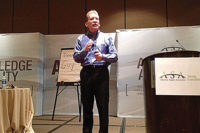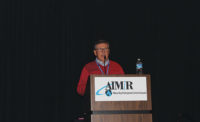Yet, a visit from a representative of the U.S. Environmental Protection Agency clearly signaled that not everyone in the international plumbing community is on the same page.
“We have reason to believe that faucets imported from China, and other nations, may contain lead in excess of levels that violate the Safe Drinking Water Act,” said Caroline Hermann of EPA’s Office of Civil Enforcement. “Testing is going on now. EPA is asking U.S. manufacturers to help identify faucets that may violate SDWA.”
Increasing numbers of imported products, and of recalls of contaminated and defective products from China and elsewhere, have prompted EPA’s focus on lead in faucets, Hermann said. EPA has adopted NSF 61, Section 9, as the voluntary standard that it applies to both domestic and imported faucets. If more than 11 parts per billion of the lead leaches into the water in the 20-day testing period, the faucet violates SDWA, Hermann said.
EPA is one of 11 U.S. governmental agencies in an inter-agency working group that was formed by an executive order July 18 to conduct a comprehensive review of import safety practices and determine where improvements can be made. The group planned to deliver its action plan to the White House in mid-November.
“EPA needs your help to identify faucets that violate SDWA,” Hermann told PMI members.
EPA has created a tip line where people can report violations: www.epa.gov/compliance/complaints/moreinfo.html.
PMI entitled its meeting “Safeguarding Our Resources” and several presentations carried a green building theme. Speakers from Great Britain, Canada and Australia said that public education is important to spread the word on water conservation in their countries.
In Great Britain, for example, 2006 was a drought year while parts of the country experienced severe flooding in 2005 and 2007. This has caused consumer confusion, said Yvonne Orgill, chief executive of the Bathroom Manufacturers Association.
Her group has launched a water-efficient product-labeling program for the United Kingdom, which Orgill called the first step in encouraging consumers to buy into water efficiency. A comprehensive Web site and database went live Sept. 1 at www.water-efficiencylabel.org.uk and lists 263 products.
Jason Borque of the Canadian Institute of Plumbing and Heating said that Canadians take water for granted, probably because the country has the largest per capita freshwater access in the world. He described Canada’s water management system as a fragmented one that forces conservation to take place at the grass-roots level vs. national policies and guidelines. Progress is being made, however.
“Our model National Plumbing Code now has a water efficiency provision, which is a big change for us,” Borque said.
In Australia, starting this year, all faucets, toilets, urinals and showers must comply with the federal Water Efficiency Labeling and Standards program, said Tim Fisher on behalf of the Plumbing Products Industry Group. A key goal of WELS is to assist conservation efforts by enabling consumers to choose water-efficient products and encouraging manufacturers to develop innovative water-saving technology.
Back in the United States, EPA’s Stephanie Tanner gave PMI members a status report on the agency’s WaterSense program.
“Regarding water efficiency, we don’t have a lot of consistency yet,” she said. “A program like WaterSense needs time in the marketplace. We’ve only been labeling products for a few months now.”






